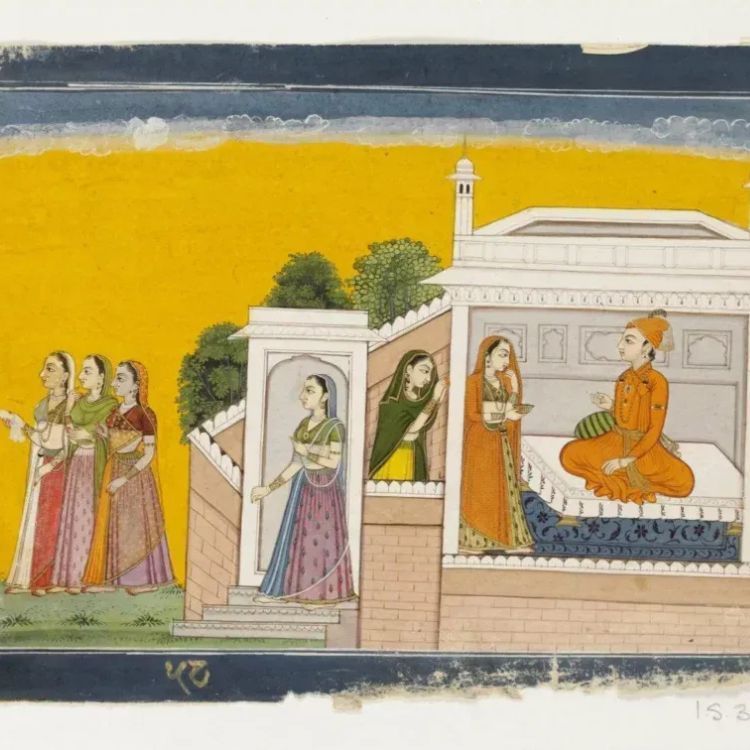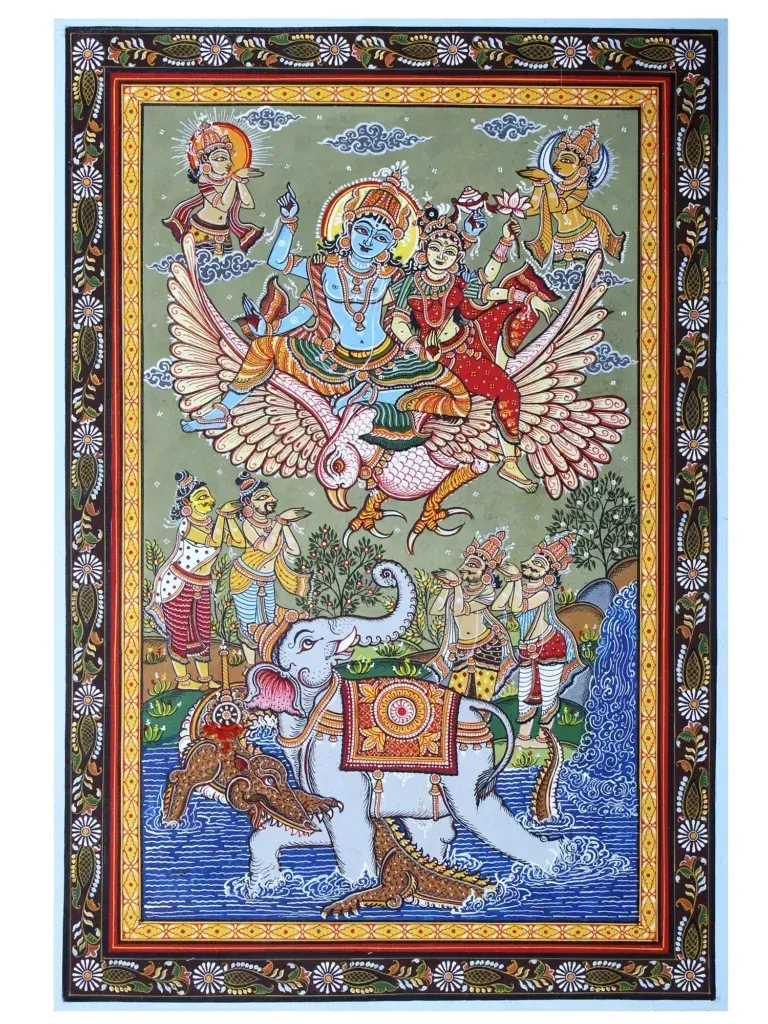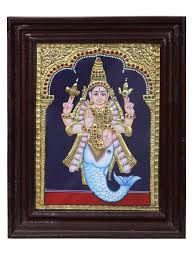Your Cart
Love, Penance, Divinity and More - Tales through Indian Art

History is not just inscribed in books but also vividly painted on the canvas of time. In India, the Indian folk and traditional art forms are a vibrant testament to the country’s rich culture and heritage. Each region of India brings its own tales of heroic deeds, love, penance and more captured through Indian art. From the intricate lines of Madhubani art to the vivid hues of Tanjore paintings, these artistic expressions not only reflect the aesthetic sensibilities of their creators but also encapsulate the deep spiritual and cultural ethos of Indian society. Through these masterpieces, we understand and uncover the lesser-known tales of virtues and life lessons.
Nala and Damyanti - Tales through Indian Art ---------------------------------------------

A tale filled with love, romance and struggle. The story of Nala and Damyanti is from the epic Mahabharata and is known for its depiction in Indian art. Damyanti, the daughter of King Bhima of Vidarbha, was renowned for her beauty and grace. Her fame spread far and wide, reaching even the ears of Nala, the handsome and virtuous king of Nishadha. They both fell in love with eachother without even having a sight or a meet.
As time went by, King Bhima decided to arrange for Damyanti’s Swayamwar. The gods heard of Damyanti’s beauty and decided to attend the event. While on their way the deities cross path with Nala and ask him to become the messenger and persuade Damyanti to marry any one of them. Very righteously, Nala does so out of respect for the gods. Damyanti remains steadfast in love for Nala. Although the gods disguise themselves to match the handsome Nala, Damyanti still finds and chooses him over everyone.
The tale seems to end here as a perfect “happily ever after” but it doesn’t. The trial and tribulations begin testing the divinity of their love for eachother. They also get separated, only to cause less suffering to eachother, but love has its own plan. Damyanti devises a plan of having another swayamwar, knowing the Nala would definitely come. And so he does, inspite of several disguises, Damyanti recognises her true love and remarries him.
Gajendra Moksha - Tales through Indian Art ------------------------------------------

This is a significant episode from Bhagavata Purana. It highlights the theme of devotion, surrendering to the almighty and divine intervention.
Gajendra is the king of elephants and resides in the lush forests of Mount Trikuta. One fine day, on his way back from a stroll, he stops at a serene lake to quench his thirst. Little did he know that death was awaiting him. A massive crocodile seizes Gajendra’s leg and causes him great pain. In spite of this strength and hard effort, the majestic elephant was not able to rescue itself from the crocodile’s powerful grip.
This is the time when he understood his efforts are futile and would need a Supreme power to rescue him. He picked a lotus flower from his trunk and raised it to the sky, as a heartfelt plea to end his suffering and save his life. The mighty elephant surrendered in this helpless situation and acknowledged the power of divine energy.
The prayer is known as Gajendra Stuti as he goes on praising the almighty and seeks deliverance from the cycle of birth and death. Impressed by his devotion, Lord Vishnu, the preserver and protector comes to rescue him. He grants Gajendra the liberation from the cycle of life and thereafter the King elephant resides in Vaikuntha, the eternal abode of Vishnu.
Matsya Avatar - Tales through Indian Art -----------------------------------------

The story underlines the theme of the cosmic cycle - creation, preservation and destruction, the importance of knowledge and spiritual guidance
The story of Matsya Avatar, the fish incarnation of Lord Vishnu, is one of the ten principal avatars (Dashavatara) in Hindu mythology. This tale, primarily found in the Matsya Purana and mentioned in other texts like the Bhagavata Purana, exemplifies themes of preservation, cosmic order, and divine intervention.
King Satyavrata, a devout and righteous ruler, was performing his daily rituals by the river. He cusps his hands to take some water when he notices a fish struggling for life. He takes the fish home to protect it out of love and compassion. To his surprise, the fish grows out of its disguise and takes the form of Lord Vishnu. The almighty informs him about the great deluge that is coming their way and expresses his wish to build a boat. The boat would contain seeds of all plants, two animals of all species(male and female). This would help King Satyavrata to begin a new civilization after the destruction of the deluge.
During the deluge, Lord Vishnu in his Matsya Avatar guided the boat and imparted sacred knowledge to Satyavrata. He ensured that the wisdom of Vedas and principles of Dharma would be preserved for future generations
Mansa Devi - Tale of Acceptance and Healing Powers --------------------------------------------------

The story of Manasa Devi, the serpent goddess, is a fascinating narrative from Hindu mythology that embodies themes of devotion, revenge, and healing. Manasa Devi is revered primarily in the states of Bengal, Assam, and Odisha.
The most prominent story associated with Manasa Devi involves her conflict with Chand Sadagar, a wealthy and devout merchant. This tale is central to the Manasa Mangal, a collection of Bengali narrative poems dedicated to the goddess. Chand Sadagar was a staunch devotee of Shiva and refused to worship Manasa. Determined to gain his devotion and prove her divinity, Manasa created numerous obstacles and calamities for Chand Sadagar and his family. Despite these misfortunes, Chand Sadagar remained steadfast in his refusal to acknowledge her. Manasa's vengeance resulted in the death of Chand Sadagar's six sons. Unyielding in his devotion to Shiva, Chand Sadagar continued to refuse Manasa's worship. Manasa then directed her wrath towards his seventh son, Lakhindar.
But this time, the seventh son's wife Behula’s unwavering devotion and purity of heart impressed the gods. She faced several obstacles but never gave up. Moved by her devotion, the gods intervened, and Manasa agreed to lift her curse. Recognizing Manasa's divine power and moved by his son's revival, Chand Sadagar finally relented. He offered worship to Manasa, acknowledging her as a goddess. Manasa Devi is widely worshipped for her ability to cure snakebites and protect against snake-related dangers. Devotees believe in her power to control serpents and prevent venomous bites.
These traditional Indian paintings not only serve as visual storytelling mediums but also preserve the rich, diverse mythological heritage of India. Each artwork offers a glimpse into the cultural values, spiritual beliefs, and artistic traditions of different regions.